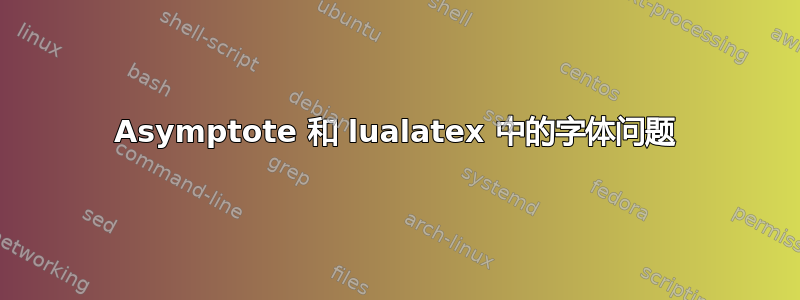
我正在尝试在渐近线中绘制一个 3-d 图形。我使用 Arial 字体作为文本以及数学字母。我正在使用命令编译文件lualatex mwi-lines.tex,asy mwi-lines*.asy然后使用命令lualatex mwi-lines.tex。以下是显示问题的 MWI。
\documentclass{article}
\usepackage{asymptote}
\usepackage{ifluatex}
\ifluatex
\makeatletter
\def\asy@input@graphic{%
\ifASYinline
\IfFileExists{"\AsyFile.tex"}{%
\catcode`:=12\relax
\@@input"\AsyFile.tex"\relax
}{%
\PackageWarning{asymptote}{file `\AsyFile.tex' not found}%
}%
\else
\IfFileExists{"\AsyFile.\AsyExtension"}{%
\ifASYattach
\ifASYPDF
\IfFileExists{"\AsyFile+0.pdf"}{%
\setbox\ASYbox=\hbox{\includegraphics[hiresbb]{\AsyFile+0.pdf}}%
}{%
\setbox\ASYbox=\hbox{\includegraphics[hiresbb]{\AsyFile.pdf}}%
}%
\else
\setbox\ASYbox=\hbox{\includegraphics[hiresbb]{\AsyFile.eps}}%
\fi
\textattachfile{\AsyFile.\AsyExtension}{\phantom{\copy\ASYbox}}%
\vskip-\ht\ASYbox
\indent
\box\ASYbox
\else
\ifASYPDF
\includegraphics[hiresbb]{\AsyFile.pdf}%
\else
\includegraphics[hiresbb]{\AsyFile.eps}%
\fi
\fi
}{%
\IfFileExists{"\AsyFile.tex"}{%
\catcode`:=12
\@@input"\AsyFile.tex"\relax
}{%
\PackageWarning{asymptote}{%
file `\AsyFile.\AsyExtension' not found%
}%
}%
}%
\fi
}
\makeatother
\fi
\usepackage{xfakebold}
\usepackage{unicode-math}
\RequirePackage{firamath-otf}
%\setmathfont{Noto Sans Math}
%\setmathfont{TeX Gyre DejaVu Math}[range={\vdots,\ddots,\mdlgblksquare,\overrightarrow}]
%\setmathfont{TeX Gyre DejaVu Math}[Scale=1.1]
\setmathfont{TeX Gyre DejaVu Math}[Scale=1.3,range={\vdots,\ddots,\mdlgblksquare,\overrightarrow,\bigcup,\oplus,\cup,\cap}]
\setmathfont{TeX Gyre DejaVu Math}[Scale=1.3,range={}]
%\setmathfont{Fira Math}[range={\pi}]
\setmainfont{Arial}[Scale=1.1]
%\newfontface\normalsize{Arial}[Scale=1.2]
\setsansfont{Arial}[Scale=MatchLowercase]
\setmathfont{Arial}[Scale=1.1,range=up/{num,Latin,latin}]
\setmathfont{Arial}[Scale=1.1,range=it/{num,Latin,latin}]
\setmathfont{Arial}[Scale=1.1,range=bfup/{num,Latin,latin}]
\setsansfont{Arial}[Scale=MatchLowercase]
\setmonofont{InconsolataN}[Scale=MatchLowercase]
\begin{document}
\begin{asy}
settings.outformat = "pdf";
settings.prc = false;
import three;
import bsp;
unitsize(1cm);
size(10cm,0);
currentprojection=orthographic((5,2,6));
//From Charles Staats's tutorial
//Direction of a point toward the camera.
triple cameradirection(triple pt, projection P=currentprojection) {
if (P.infinity) {
return unit(P.camera);
} else {
return unit(P.camera - pt);
}
}
triple towardcamera(triple pt, real distance=1, projection P=currentprojection) {
return pt + distance * cameradirection(pt, P);
}
draw(O -- 5X,blue+linewidth(1pt),arrow=Arrow3(DefaultHead2,emissive(blue)));
draw(O -- 5Y, green+linewidth(1pt),arrow=Arrow3(DefaultHead2,emissive(green)));
draw(O -- 5Z, red+linewidth(1pt),arrow=Arrow3(DefaultHead2,emissive(red)));
draw(O -- -5X,blue+linewidth(1pt),arrow=Arrow3(DefaultHead2,emissive(blue)));
draw(O -- -5Y, green+linewidth(1pt),arrow=Arrow3(DefaultHead2,emissive(green)));
draw(O -- -5Z, red+linewidth(1pt),arrow=Arrow3(DefaultHead2,emissive(red)));
path3 pl1 = ((5,-5,5) -- (-5,-5,5) -- (-5,5,-5) -- (5,5,-5) -- cycle);
dot((5,-5,5) ^^ (-5,-5,5) ^^ (-5,5,-5) ^^ (5,5,-5),3+black);
surface spl1=surface(pl1);
draw(spl1,yellow+opacity(1),light=nolight);
dot((5,-5,5) ^^ (-5,-5,5) ^^ (-5,5,-5) ^^ (5,5,-5),3+black);
draw((5,-4,4) -- (-5,-4,4),black+linewidth(1pt));
dot((0,-4,4),black+5);
label("$\mathbf{P_1}$",align=NW,position=towardcamera((0,-4,4)));
dot((0,4,-4),black+5);
label("$\mathbf{P_2}$",align=SE,position=towardcamera((0,3,-3)));
label("$L_2$",align=SW,position=towardcamera((5,4,-4)));
draw((5,4,-4) -- (-5,4,-4), black+linewidth(1pt));
path3 pl2 = ((5,5,5) -- (-5,5,5) -- (-5,-5,-5) -- (5,-5,-5) -- cycle);
surface spl2=surface(pl2);
draw(spl2,orange+opacity(1),light=nolight);
path3 pl = ((0,-5,-5) -- (0,5,-5) -- (0,5,5) -- (0,-5,5) -- cycle);
dot((5,5,5) ^^ (-5,5,5) ^^ (-5,-5,-5) ^^ (5,-5,-5),3+black);
surface spl=surface(pl);
draw(spl,lightblue+opacity(1),light=nolight);
label("$L_1$",align=W,position=towardcamera((5,-4,4)));
dot((0,4,4),black+5);
label("$\mathbf{P_3}$",align=W,position=towardcamera((0,4,4)));
draw((5,4,4) -- (-5,4,4), linewidth(1pt));
label("$L_3$",align=SE,position=towardcamera((5,4,4)));
dot((0,1,1),black+5);
label("$\mathbf{P_4}$",align=W,position=towardcamera((0,1,1)));
draw((5,1,1) -- (-5,1,1), black+linewidth(1pt));
label("$L_4$",align=SE,position=towardcamera((5,1,1)));
label("$y-z=0$",align=SE,position=towardcamera((-5,5,5)));
label("$y+z=0$",align=SE,position=towardcamera((-5,-5,5)));
\end{asy}
\(\mathbf{P_2}\), \(L_1\)
\end{document}
在输出中,图中的标签不是 Arial 格式的。但是,下面的文本以 Arial 格式显示,没有任何问题。
答案1
周围 LaTeX 代码中的字体设置不会自动传输到 Asymptote 代码。如果您检查(这是生成图形时mwi-lines-1.asy唯一能看到的东西),那么您将看不到任何字体命令。asy
settings.tex="lualatex";您可以使用和语句将它们添加到 Asymptote 代码中texpreamble("")。代码片段:
\begin{asy}
settings.tex="lualatex";
settings.outformat = "pdf";
settings.prc = false;
texpreamble("\usepackage{unicode-math}\setmathfont{TeX Gyre DejaVu Math}\setmathfont{Nimbus Sans}[Scale=1.1,range=up/{num,Latin,latin}]
\setmathfont{Nimbus Sans}[Scale=1.1,range=it/{num,Latin,latin}]
\setmathfont{Nimbus Sans Bold}[Scale=1.1,range=bfup/{num,Latin,latin}]");
我使用了 Nimbus Sans,因为我没有安装 Arial,但它应该是类似的。
请注意,unicode-math您可以使用\symbf而不是来加粗数学。还请注意,您应该使用 范围\mathbf指定 的加粗变体。\setmathfontbfup
完整 MWE
\documentclass{article}
\usepackage{asymptote}
\usepackage{ifluatex}
\ifluatex
\makeatletter
\def\asy@input@graphic{%
\ifASYinline
\IfFileExists{"\AsyFile.tex"}{%
\catcode`:=12\relax
\@@input"\AsyFile.tex"\relax
}{%
\PackageWarning{asymptote}{file `\AsyFile.tex' not found}%
}%
\else
\IfFileExists{"\AsyFile.\AsyExtension"}{%
\ifASYattach
\ifASYPDF
\IfFileExists{"\AsyFile+0.pdf"}{%
\setbox\ASYbox=\hbox{\includegraphics[hiresbb]{\AsyFile+0.pdf}}%
}{%
\setbox\ASYbox=\hbox{\includegraphics[hiresbb]{\AsyFile.pdf}}%
}%
\else
\setbox\ASYbox=\hbox{\includegraphics[hiresbb]{\AsyFile.eps}}%
\fi
\textattachfile{\AsyFile.\AsyExtension}{\phantom{\copy\ASYbox}}%
\vskip-\ht\ASYbox
\indent
\box\ASYbox
\else
\ifASYPDF
\includegraphics[hiresbb]{\AsyFile.pdf}%
\else
\includegraphics[hiresbb]{\AsyFile.eps}%
\fi
\fi
}{%
\IfFileExists{"\AsyFile.tex"}{%
\catcode`:=12
\@@input"\AsyFile.tex"\relax
}{%
\PackageWarning{asymptote}{%
file `\AsyFile.\AsyExtension' not found%
}%
}%
}%
\fi
}
\makeatother
\fi
\usepackage{xfakebold}
\usepackage{unicode-math}
\RequirePackage{firamath-otf}
%\setmathfont{Noto Sans Math}
%\setmathfont{TeX Gyre DejaVu Math}[range={\vdots,\ddots,\mdlgblksquare,\overrightarrow}]
%\setmathfont{TeX Gyre DejaVu Math}[Scale=1.1]
\setmathfont{TeX Gyre DejaVu Math}[Scale=1.3,range={\vdots,\ddots,\mdlgblksquare,\overrightarrow,\bigcup,\oplus,\cup,\cap}]
\setmathfont{TeX Gyre DejaVu Math}[Scale=1.3,range={}]
%\setmathfont{Fira Math}[range={\pi}]
\setmainfont{Nimbus Sans}[Scale=1.1]
%\newfontface\normalsize{Nimbus Sans}[Scale=1.2]
\setsansfont{Nimbus Sans}[Scale=MatchLowercase]
\setmathfont{Nimbus Sans}[Scale=1.1,range=up/{num,Latin,latin}]
\setmathfont{Nimbus Sans}[Scale=1.1,range=it/{num,Latin,latin}]
\setmathfont{Nimbus Sans Bold}[Scale=1.1,range=bfup/{num,Latin,latin}]
\setsansfont{Nimbus Sans}[Scale=MatchLowercase]
\setmonofont{InconsolataN}[Scale=MatchLowercase]
\begin{document}
\begin{asy}
settings.tex="lualatex";
settings.outformat = "pdf";
settings.prc = false;
texpreamble("\usepackage{unicode-math}\setmathfont{TeX Gyre DejaVu Math}\setmathfont{Nimbus Sans}[Scale=1.1,range=up/{num,Latin,latin}]
\setmathfont{Nimbus Sans}[Scale=1.1,range=it/{num,Latin,latin}]
\setmathfont{Nimbus Sans Bold}[Scale=1.1,range=bfup/{num,Latin,latin}]");
import three;
import bsp;
unitsize(1cm);
size(10cm,0);
currentprojection=orthographic((5,2,6));
//From Charles Staats's tutorial
//Direction of a point toward the camera.
triple cameradirection(triple pt, projection P=currentprojection) {
if (P.infinity) {
return unit(P.camera);
} else {
return unit(P.camera - pt);
}
}
triple towardcamera(triple pt, real distance=1, projection P=currentprojection) {
return pt + distance * cameradirection(pt, P);
}
draw(O -- 5X,blue+linewidth(1pt),arrow=Arrow3(DefaultHead2,emissive(blue)));
draw(O -- 5Y, green+linewidth(1pt),arrow=Arrow3(DefaultHead2,emissive(green)));
draw(O -- 5Z, red+linewidth(1pt),arrow=Arrow3(DefaultHead2,emissive(red)));
draw(O -- -5X,blue+linewidth(1pt),arrow=Arrow3(DefaultHead2,emissive(blue)));
draw(O -- -5Y, green+linewidth(1pt),arrow=Arrow3(DefaultHead2,emissive(green)));
draw(O -- -5Z, red+linewidth(1pt),arrow=Arrow3(DefaultHead2,emissive(red)));
path3 pl1 = ((5,-5,5) -- (-5,-5,5) -- (-5,5,-5) -- (5,5,-5) -- cycle);
dot((5,-5,5) ^^ (-5,-5,5) ^^ (-5,5,-5) ^^ (5,5,-5),3+black);
surface spl1=surface(pl1);
draw(spl1,yellow+opacity(1),light=nolight);
dot((5,-5,5) ^^ (-5,-5,5) ^^ (-5,5,-5) ^^ (5,5,-5),3+black);
draw((5,-4,4) -- (-5,-4,4),black+linewidth(1pt));
dot((0,-4,4),black+5);
label("$\symbf{P_1}$",align=NW,position=towardcamera((0,-4,4)));
dot((0,4,-4),black+5);
label("$\symbf{P_2}$",align=SE,position=towardcamera((0,3,-3)));
label("$L_2$",align=SW,position=towardcamera((5,4,-4)));
draw((5,4,-4) -- (-5,4,-4), black+linewidth(1pt));
path3 pl2 = ((5,5,5) -- (-5,5,5) -- (-5,-5,-5) -- (5,-5,-5) -- cycle);
surface spl2=surface(pl2);
draw(spl2,orange+opacity(1),light=nolight);
path3 pl = ((0,-5,-5) -- (0,5,-5) -- (0,5,5) -- (0,-5,5) -- cycle);
dot((5,5,5) ^^ (-5,5,5) ^^ (-5,-5,-5) ^^ (5,-5,-5),3+black);
surface spl=surface(pl);
draw(spl,lightblue+opacity(1),light=nolight);
label("$L_1$",align=W,position=towardcamera((5,-4,4)));
dot((0,4,4),black+5);
label("$\symbf{P_3}$",align=W,position=towardcamera((0,4,4)));
draw((5,4,4) -- (-5,4,4), linewidth(1pt));
label("$L_3$",align=SE,position=towardcamera((5,4,4)));
dot((0,1,1),black+5);
label("$\symbf{P_4}$",align=W,position=towardcamera((0,1,1)));
draw((5,1,1) -- (-5,1,1), black+linewidth(1pt));
label("$L_4$",align=SE,position=towardcamera((5,1,1)));
label("$y-z=0$",align=SE,position=towardcamera((-5,5,5)));
label("$y+z=0$",align=SE,position=towardcamera((-5,-5,5)));
\end{asy}
\(\symbf{P_2}\), \(L_1\)
\end{document}
结果:




